Your 5-Step Guide to Content Marketing for Schools

You’ve likely heard the phrase, “Content is King,” if you’ve collaborated with a marketing agency. This content spans a spectrum, ranging from engaging Tweets and entertaining Instagram videos to long-form articles on your school’s website.
However, creating content isn’t enough to establish awareness or visibility for your school. To truly engage and inform your target audience, that will drive them to take the desired actions, content needs to be paired with marketing.
Now, what is content marketing for schools? Why do schools need a well-defined content marketing strategy?
The Content Marketing Institute (CMI) defines content marketing as “a strategic marketing approach focused on creating and distributing valuable, relevant, and consistent content to attract and retain a clearly defined audience—and, ultimately, to drive profitable customer action.“
Here are some stats that prove only creating content without a strategy is not enough:
-
Studies indicate that B2B content marketing generates 3x more leads than all traditional marketing forms while saving up to 62% of overall expenditure.
-
According to the 2022 Demand Gen Report, 61% of B2B buyers read three to seven content pieces before trusting a brand.
-
A survey conducted by SEMrush indicated that 9 out of 10 marketers achieved success with their content marketing efforts in 2021.
Schools often encounter a myriad of challenges when striving to connect with their target audience, encompassing students, parents, and educators. These challenges can impede effective communication and engagement, impacting the overall success and reputation of the school.
Content marketing strategies for schools are vital for them to stand out and present their unique offerings. It enables you to align your content with your school’s goals, whether that be boosting enrollment, enhancing brand perception, or increasing community involvement.
By developing a compelling content marketing strategy, you ensure that every piece of content produced serves a specific purpose within the larger framework of your objectives. This strategy involves understanding your audience, tailoring content to meet their needs, and strategically distributing it through appropriate channels.
As we’ve mentioned before, creating content is one part of content marketing for schools. Implementing it effectively and distributing it across the right channels is another aspect of the process.
Let’s take a look at the 5 steps to create and implement an effective content marketing strategy for both public and private schools.
Step One: Identifying Your Audience
Understanding your target audience is the first step in any effective marketing strategy, especially in the education sector. A thorough grasp of your audience’s demographics, interests, and educational needs informs content creation and guides a school’s overall communication strategy.
For example, think about:
-
What aspects of our school resonate most with current parents?
-
What specific elements contribute to parental satisfaction and loyalty?
-
What are the frequently asked questions from parents considering enrollment?
-
What specialized programs or certifications distinguish your school?
-
What are the most common parenting challenges within your community?
Identifying the educational needs of students and the expectations of parents and educators helps in customizing educational offerings. This ensures that the school addresses specific challenges and provides valuable solutions, ultimately fostering a deeper connection with the school.
Now, this raises another question: how do you conduct audience research?
-
Conducting surveys is an effective way to gather quantitative data about your audience.
-
Hosting focus groups allows for more in-depth qualitative insights. These sessions provide a platform for open discussions, allowing schools to directly identify unmet needs, concerns, and preferences from the source.
-
Monitoring online behavior, such as website analytics and social media interactions, offers valuable data about audience preferences.
Mercy Academy, situated in Louisville, Kentucky, stands out among the many all-girl high schools by crafting a distinctive narrative. Mercy has uniquely reimagined its story in a landscape where schools have similar communities and curriculums.
How did they achieve this? By tapping into something that deeply resonates with young girls – fairy tales – and infusing it with a fresh perspective.
The school’s recent advertising campaign, under the tagline “Prepare for real life,” was imagined in both traditional and online advertising against fairy tale ideals:

The school explains its positioning uniquely:
“In high school, most students have the same question… “When am I going to use this?” At Mercy, we answer that question. Our curriculum is designed around applying knowledge to real-life problems, so our students learn how to think critically while being innovative. These skills, along with the basics in the core content areas, like Math, English, and Science, will prepare you to excel in college and be successful in the real world to follow.”
Step Two: Creating Educational and Engaging Content
Now, let’s talk about developing a plan for the content you will create. It’s essential to consider what kind of content will suit your audience and your overall goals.
Your content plan should have a mix of different types of content, like:
-
Blog posts
-
Real-life examples
-
Infographics
-
E-books
-
Newsletters
-
Videos
-
Online seminars
-
Podcasts
Once you’ve got this detailed content plan, you’re on track to create top-notch content that grabs your audience’s attention and boosts both engagement and enrollment.
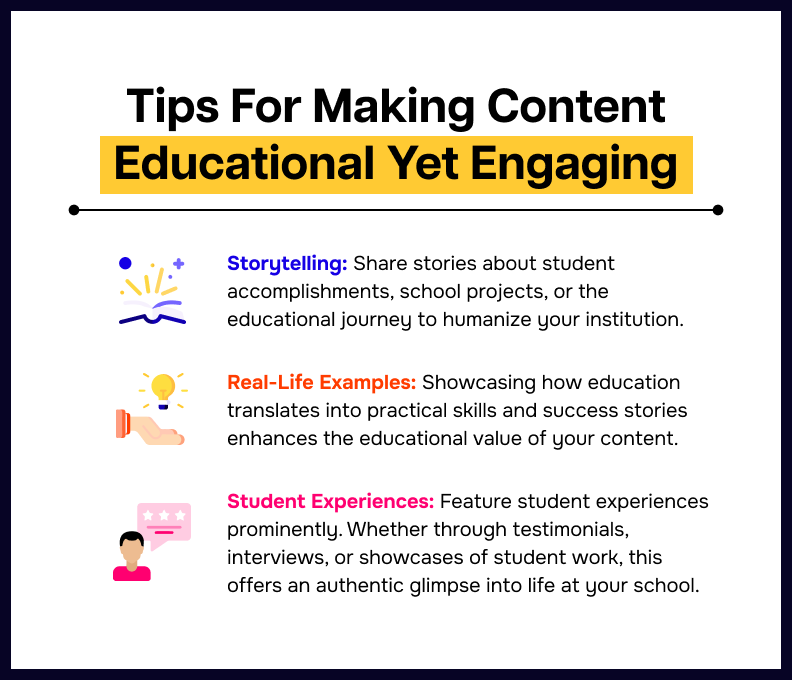
One great example of a successful school blog is the “Edutopia Blog” by the George Lucas Educational Foundation. Edutopia is dedicated to sharing innovative and effective teaching strategies, resources, and insights.
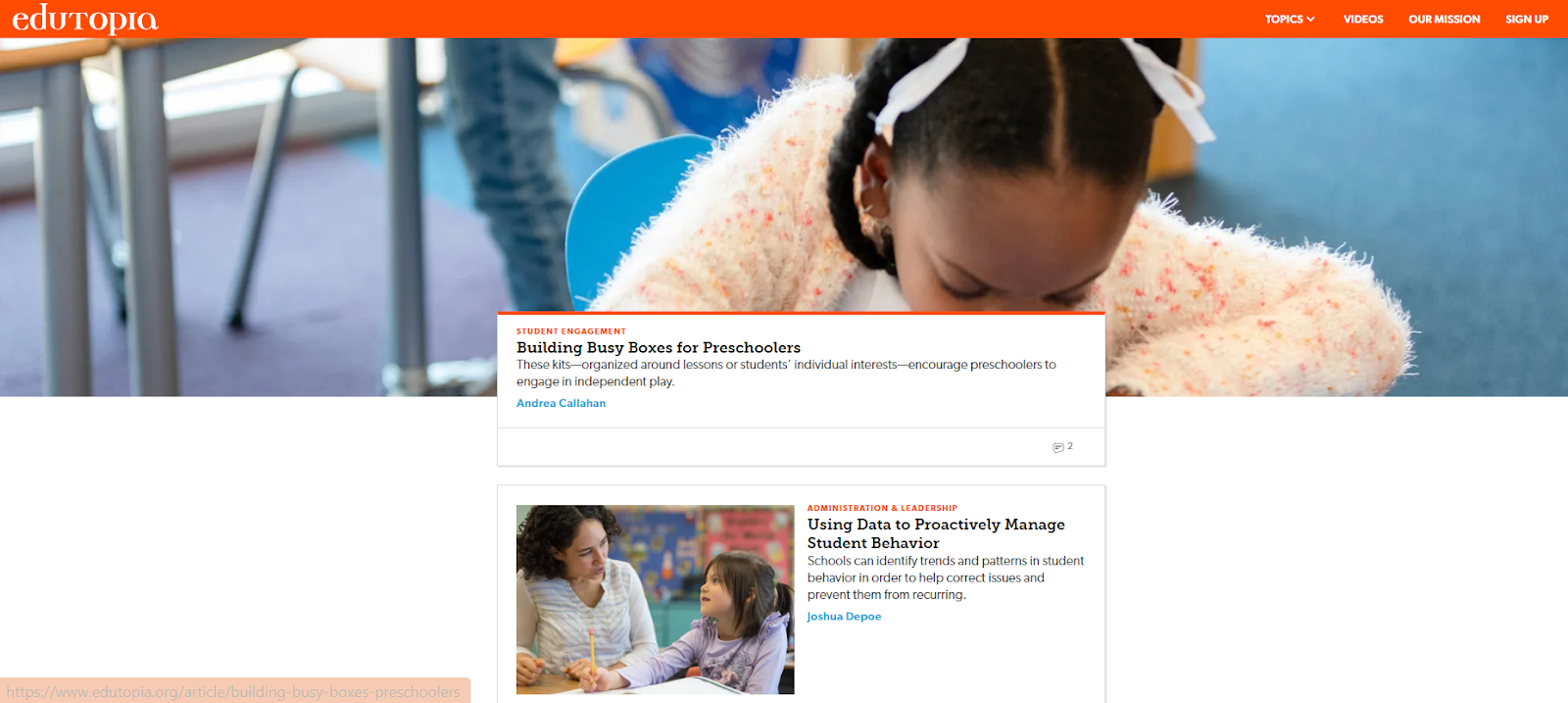
Edutopia covers a wide range of topics, from project-based learning and classroom management to technology integration and social-emotional learning. This diversity ensures that educators with varied interests can find valuable information.
Another brilliant example is that of The University of Toronto, which has a dedicated podcast page on its school website, covering a range of topics to better appeal to its students.
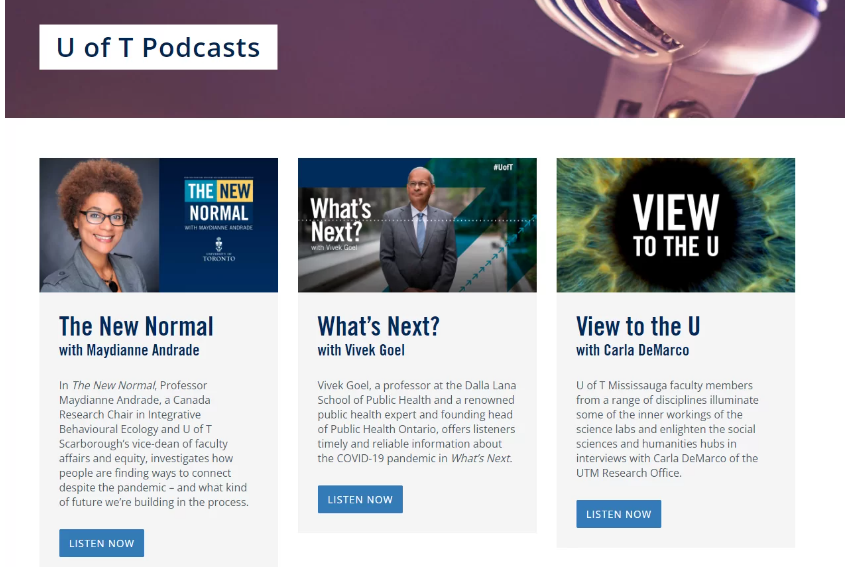
Step Three: Utilizing the Right Platforms
Selecting the right platforms is important for effectively reaching and engaging your school community. Common platforms include social media, the school website, and email. With its widespread reach, social media fosters community interaction but may lack depth.
However, the good thing is that young people spend considerable time on social media platforms. In fact, a study by the Pew Research Center indicated that 71% of Americans ages 13 to 17 use Facebook, 52% use Instagram, 41% use Snapchat, 33% use Twitter, and 71% regularly use more than one of these social networks.
On the other hand, a school’s website offers comprehensive information but requires users to actively seek it. Email is a direct communication channel but may face saturation.
Tailoring the use of each platform to a school’s needs involves navigating these factors strategically. By tailoring how you share your content, you’re more likely to connect with the audience you want to reach.
To maximize impact, consider integrating content seamlessly across platforms. For instance, share engaging social media snippets linking to in-depth articles on the school website, complemented by targeted email newsletters.
The Harker School is a private, non-profit school in San Jose, California. It effectively leverages social media for quick updates, maintains a comprehensive school website for detailed information, and employs email newsletters for personalized communication, ensuring a cohesive and effective online presence.
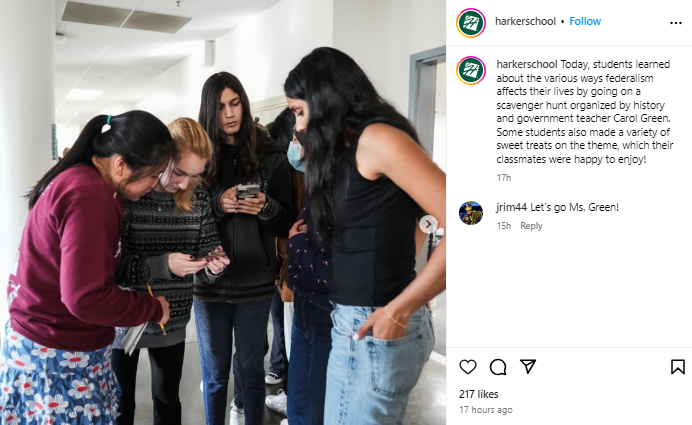
The Harker School leverages the dynamic nature of platforms like Facebook, Twitter, and Instagram to share quick snapshots of daily activities, accomplishments, and important announcements. This multi-platform strategy caters to different audience preferences and behaviors, whether it’s brief updates, visual highlights, or interactive content.
Step Four: Measuring Success and Iterating
Effective content marketing for private schools or public universities doesn’t end with creating and implementing strategies; it requires measuring success and iterating to improve continually.
The mantra, “Measure, Analyze, and Adjust,” is the compass guiding the trajectory of success.
Tools and Metrics for Evaluating Content Marketing Success
-
Engagement Rates: Monitor the level of interaction your content receives. This includes likes, shares, comments, and other forms of audience engagement. Tools like Google Analytics, SEMRush, social media analytics like LinkedIn Analytics, and content management systems like HubSpot can provide valuable data on engagement.
-
Website Traffic: Keep a close eye on the traffic your content generates. Analyze which pieces are driving the most visitors to your website and understand the sources of this traffic. Google Analytics and other website analytics tools can help in tracking website performance.
-
Enrollment Numbers: For schools, enrollment is a crucial metric. Measure how your content marketing efforts impact student enrollment and retention. This involves tracking the journey of prospective students from content engagement to enrollment.
Once you’ve gathered data on engagement, website traffic, and enrollment numbers, it’s time to analyze and draw meaningful conclusions. Identify the content that performs exceptionally well and understand why. Likewise, highlight areas where improvement is needed. Feedback not only helps identify areas of improvement but also builds the connection between the school and its audience.

You can do this check every few weeks or a month to stay on top of your progress.
Step Five: Community Involvement and Collaboration
Now, community involvement and collaboration play a crucial role in the success of school content marketing strategies.
Here’s how you can involve the community in the content creation process:
-
Encourage students, parents, and community members to share their stories, experiences, and perspectives. This can be done through guest blog posts, testimonials, or even user-generated content on social media.
-
Actively seek input from parents to understand their expectations, concerns, and aspirations. Create content that addresses these insights, building a stronger connection between the school and the families it serves.
-
Promote and cover local events, initiatives, and achievements. This demonstrates the school’s commitment to the community and provides valuable, relevant content that resonates with your audience.
You can also collaborate with local businesses and alumni members for content diversity.
For example, guest lectures, workshops, and collaborative projects with local businesses can provide students with practical knowledge and enhance the credibility of your content.
Partner with other educational institutions for joint projects, knowledge exchange, or collaborative events. This broadens the scope of your content and creates a network that benefits both institutions. Leverage alums’ experiences by featuring their success stories, career paths, and contributions to society. Alumni involvement adds authenticity to your content and showcases the long-term impact of your institution.
Embracing community engagement and collaboration enriches the unique mission of your school, fostering a dynamic and interconnected educational environment.
Wrapping Up
It’s evident that a successful content marketing strategy for schools requires consistent, high-quality content creation and active engagement through well-managed social media platforms. However, the challenge lies in dedicating the necessary time and expertise to these tasks, which can exhaust existing resources within a school.
Trying to allocate content creation and online presence management tasks to your already-busy staff might seem feasible initially, but it often results in either delayed projects or content that doesn’t meet the desired quality standards. To avoid this, schools can opt for a more efficient and specialized approach by partnering with trusted professionals.
Pepper Content is a reliable partner specializing in content writing services for public and private schools. By partnering with Pepper Content, schools gain access to a dedicated team that understands its unique goals and attributes. This partnership ensures the creation of tailored content marketing strategies that resonate with the target audience and reduce the burden on in-house staff, allowing them to focus on their primary responsibilities without compromising content quality.
Book a demo today to embark on a journey of impactful content marketing for your school!
Latest Blogs
In this blog, explore the golden rules of using AI marketing tools so you can leverage the benefits to their maximum potential.
In this blog, you’ll learn how to avoid the pitfalls of SEO over-optimization while enhancing your site’s performance.
In this article, we’ll take a look at what AMP is, its advantages and disadvantages, and how it affects SEO.
Get your hands on the latest news!
Similar Posts

Content Strategy
8 mins read
Connect Deeper, Sell Smarter: 7 UGC Campaigns That Transformed Brand-Customer Relationships

Content Strategy
8 mins read
5 Ways to Use Long-form Content in Digital Marketing
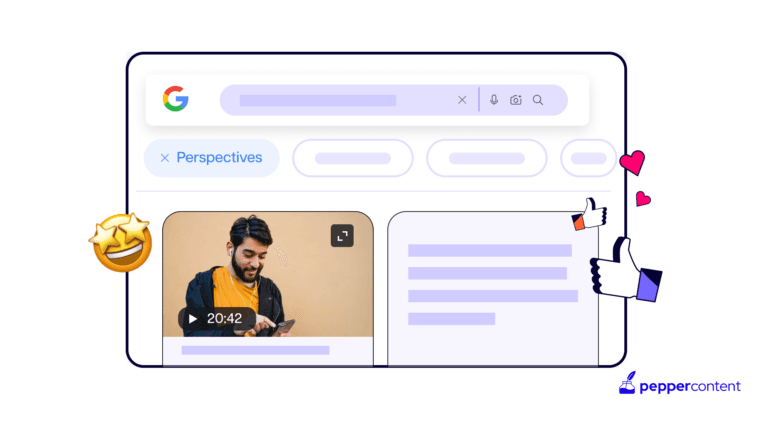
Content Strategy
8 mins read